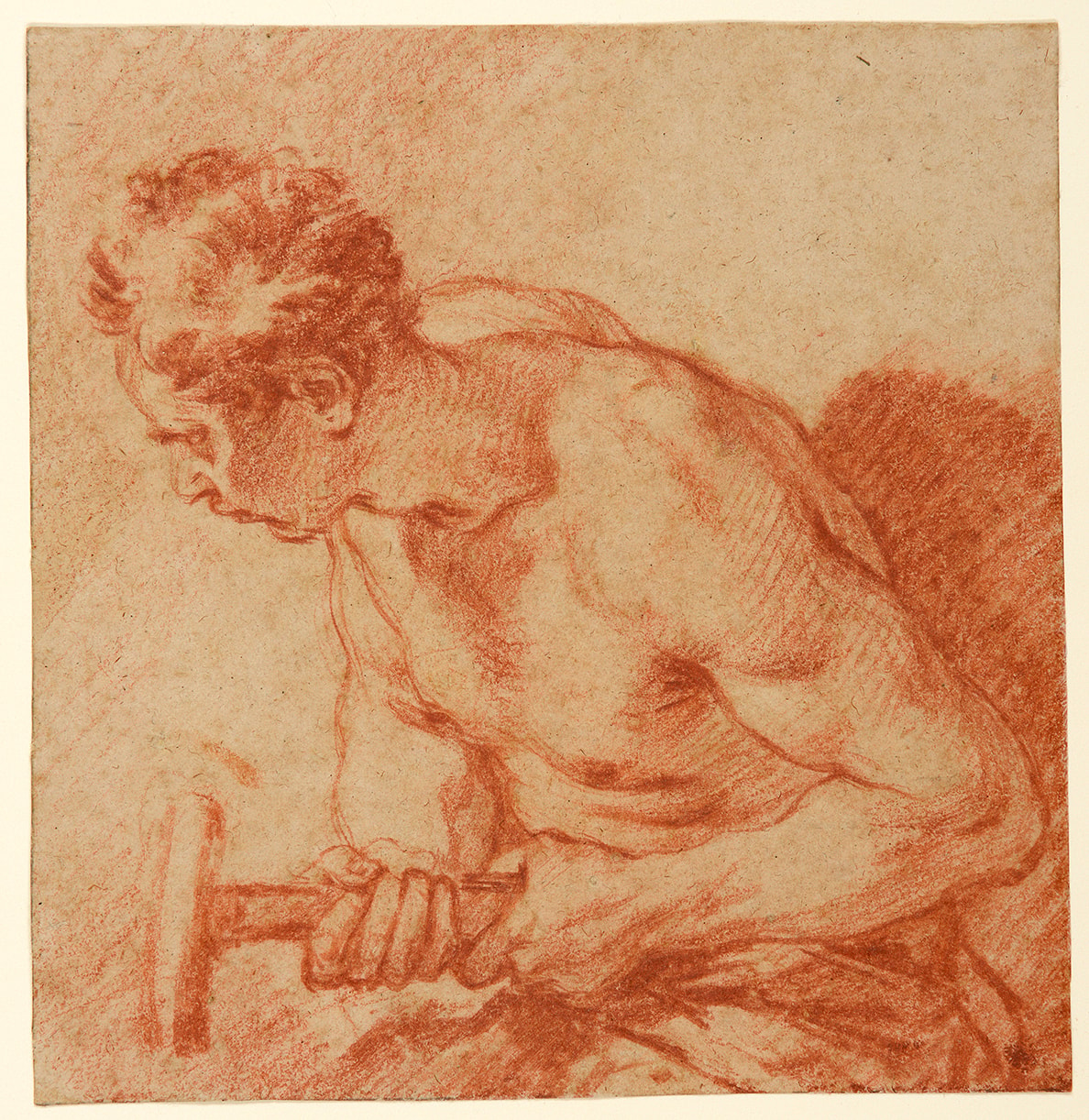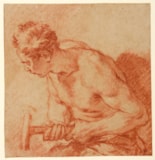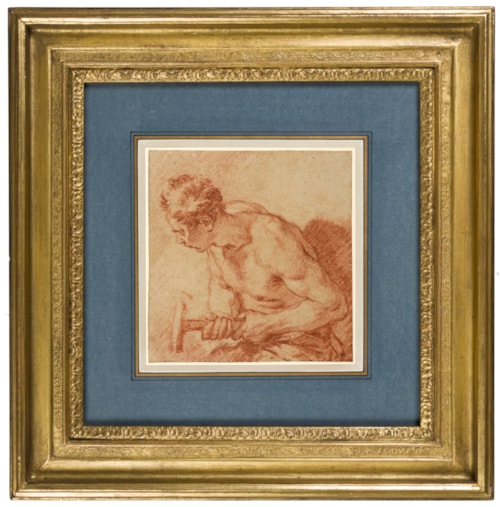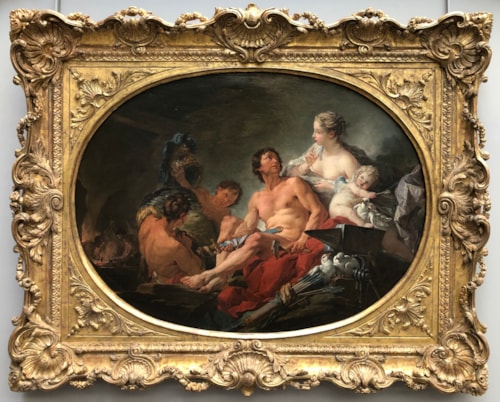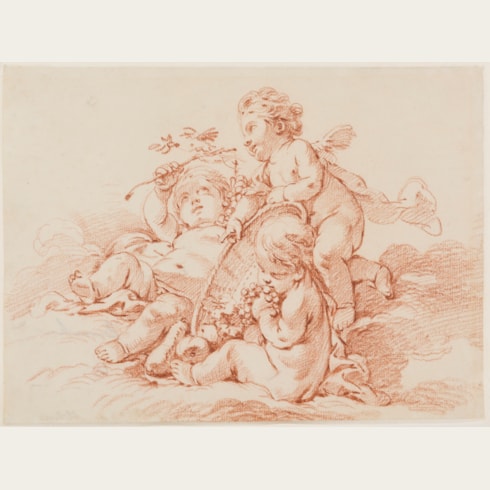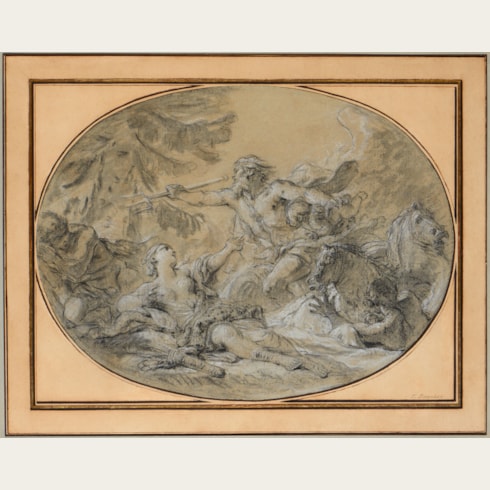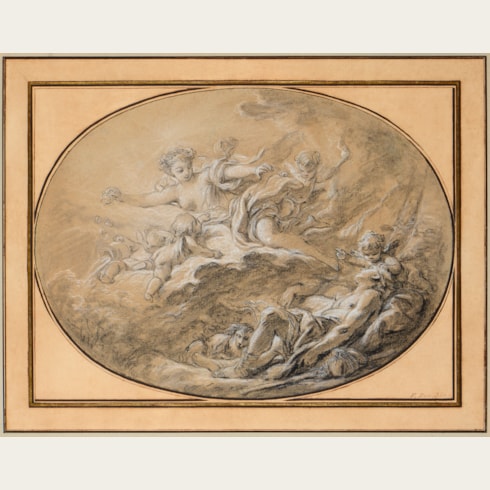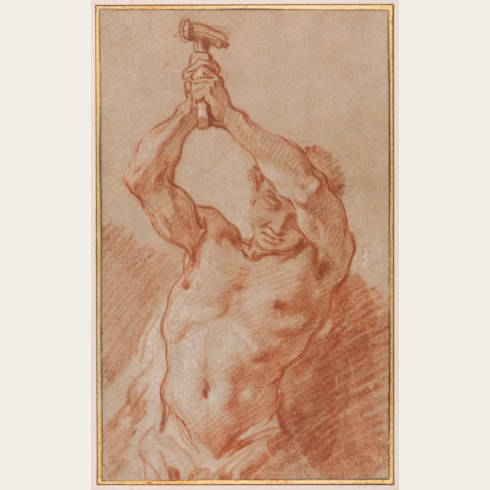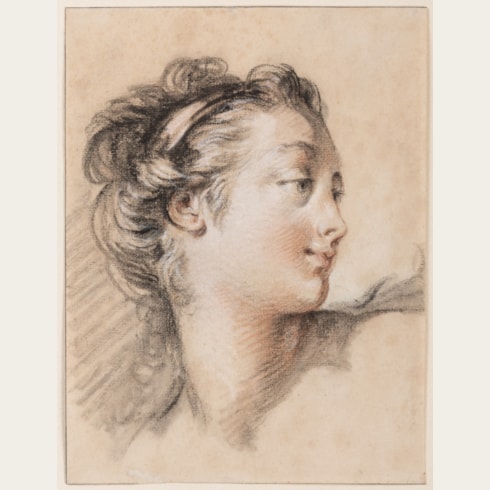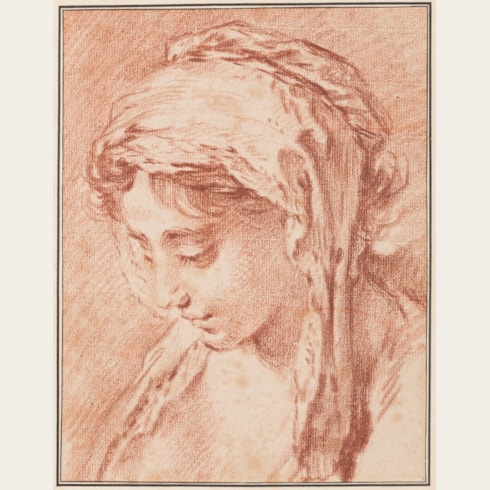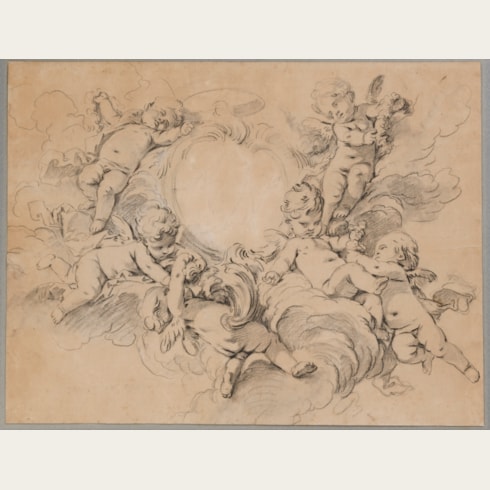François BOUCHER
(Paris 1703 - Paris 1770)
Study of a Male Nude Holding a Hammer
191 x 184 mm. (7 1/2 x 7 1/4 in.)
It has been suggested, however, that the Venus at the Forge of Vulcan and a pendant painting of Venus Presenting Aeneas to the Gods (or The Apotheosis of Aeneas), now in the Musée-Promenade de Marly-le-Roi in Louveciennes, may have initially been commissioned in 1746 for the redecorated apartments of the soon to be married Dauphin at Versailles, before the intended destination of the works was changed to Marly. The painting of Venus at the Forge of Vulcan is described in the mémoire as ‘4 pieds de long sur 3 et demi de haute représente Vénus qui prie Vulcain de forger des arms pour Enée; ce tableau est compose de huit figures’, and in the 1747 Salon livret as ‘Un Tableau ovale, representant les Forges de Vulcain. Ce tableau est destine pour la Chambre à coucher du Roy à Marly’. Boucher received the final payment for both works in February 1748. Not long thereafter the composition was adapted and enlarged by the artist in a design for a tapestry to be woven at the Beauvais tapestry works.
Boucher presumably drew the present sheet before he had determined the definitive composition of the painting. Although the figure is reversed in the final painting, and the artist may therefore have used a counterproof of this drawing to reorient the figure, the position of the hands in the drawing is close to that of the right-hand forger in the painting. The present sheet may also have been used for a similar figure in the Beauvais tapestry noted above.
Boucher was particularly fond of the subject of Venus at the Forge of Vulcan, and treated it several times in his career, in paintings, drawings and tapestry cartoons. Taken from Virgil’s epic Aeneid, the theme of the goddess visiting Vulcan’s forge on Mount Etna to ask her estranged husband to provide arms for her illegitimate mortal son Aeneas, to which he agrees only after her seduction of him, had great appeal for the artist, and undoubtedly for his patrons as well. As Edith Standen has noted of the theme, ‘One can only speculate why this particular mythological subject was so popular with Boucher’s patrons, including Louis XV. Perhaps the reason was that it provided such a piquant contrast between the soft whiteness of Venus, with her nymphs, cupids, and doves, and the masculinity of Vulcan and his fierce helpers at their noisy and dirty labors. Boucher, in fact, has been quoted as recommending the subject to a pupil whose noble patron had asked for a painting. He said it was “une tâche fort attrayante à remplir: le dessin d’une belle figure de femme environnée d’Amours, la silhouette d’un homme musculeux accompagnée de quelques cyclopes à l’arrière-plan.”’
As Françoise Joulie has noted of such drawings as these by Boucher, intended not as academies but as studies for paintings, ‘They are perhaps some of the maître’s finest drawings, because his knowledge and mastery of anatomical drawing were internalized to give precedence to studies of posture in a composition.’
Appointed a professor at the Académie Royale in 1735, Boucher painted numerous easel pictures – pastoral landscapes, religious and mythological subjects, genre scenes, chinoiseries and portraits – for private clients in France, Sweden, Denmark, Germany and Poland, while also producing several tapestry cartoons for the Beauvais and Gobelins manufactories, where he succeeded Jean-Baptiste Oudry as inspecteur des ouvrages in 1755. He designed stage sets and costumes for the Opéra and the Opéra-Comique in the 1740s and created designs for Vincennes and later Sèvres porcelain throughout the 1750s and early 1760s. In 1765 Boucher was named premier peintre du roi, or First Painter to the King, and also appointed director of the Académie Royale. In 1770 he died at his lodgings in the Louvre and was buried in the church of Saint-Germain l’Auxerrois. Among his pupils were Jean-Baptiste Deshays and Pierre-Antoine Baudouin, both of whom became his sons-in-law and predeceased him, as well as Jean-Honoré Fragonard, Jean-Baptiste Le Prince and Gabriel-Jacques de Saint-Aubin.
A gifted draughtsman, François Boucher was as prolific as he was talented, and claimed to have produced ten thousand drawings over a career that lasted some fifty years. He was, in fact, perhaps the most prolific French draughtsman of the eighteenth century, and his drawn oeuvre includes pastoral scenes, nudes, religious, historical and mythological subjects, book illustrations, chinoiseries, landscapes, genre scenes, studies of children and heads, as well as designs for tapestries, porcelain and fountains. Although most of his drawings were preparatory studies for his paintings, Boucher also produced finished drawings as independent works, often adapting and elaborating a head or figure from one of his paintings. While his preference was for black, red, and (particularly in his later years) a dark brown chalk, he also made highly finished drawings in pastel and, at times, drew on coloured paper. As Pierre Rosenberg has succinctly noted, ‘Boucher’s love of drawing never waned with time and success. Admittedly, drawing was kept in its proper place, as a vital link between the conception or the idea of a work or composition, and its realization, its metamorphosis into a painting…To quote Mariette, Boucher “was a born painter”, but he placed great emphasis on drawing throughout his entire career.’ Boucher’s drawings were avidly collected in his lifetime by such connoisseurs as Barthelémy-Augustin Blondel d’Azaincourt, Paul Randon de Boisset, Pierre-Jacques-Onésyme Bergeret de Grancourt, Gilbert Paignon-Dijonval, Jean-Claude Gaspard de Sireuil, Count Carl Gustaf Tessin, and many others.
Boucher's drawn oeuvre includes all manner of subjects, including pastoral scenes, nudes, religious, historical and mythological subjects, book illustrations, chinoiseries, landscapes, nudes, genre scenes, studies of children and heads, as well as designs for tapestries, porcelain and fountains. He produced many finished drawings as independent works, often adapting and elaborating a head or figure from one of his paintings. While his preference was for black, red, and (particularly in his later years) brown chalk, Boucher also made highly finished drawings in pastel and, at times, drew on coloured paper. A large number of his drawings were finished works for collectors and the art market, and many were engraved and reproduced in considerable numbers – often making use of new printmaking techniques that allowed chalk drawings to be reproduced with a high degree of verisimilitude - by such printmakers as Louis-Marin Bonnet, Gilles Demarteau or Gabriel Huquier. His drawings were greatly admired, and while many were preparatory studies for his paintings, others were produced as finished works of art, to be sold to collectors or reproduced by engravers. Indeed, Boucher’s popularity as a draughtsman owes much to the fact that many of his drawings were reproduced and widely distributed as engravings.
Provenance
Gisèle Weinberger, Paris
Thomas Le Claire, Hamburg, in 1994
Anonymous sale, London, Christie’s, 2 July 1996, lot 242
Bernadette and William M. B. Berger, Denver, Colorado
The Berger Collection Educational Trust.
Literature
Exhibition

